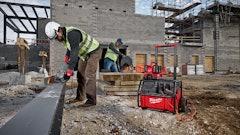
The orange “X” crisis markings on the sides of homes are still visible. Their ominous message registered counterclockwise the date the house was searched, the National Guard division that searched it, and how many were found dead inside. It’s a chilling reminder of Katrina’s devastation slightly more three years removed, but what seems like a lifetime for New Orleans residents—including landscape contractor Dan Standley.
“I won’t even drive by some of the more ravaged communities,” Standley says as he maneuvers his pickup along neighborhood streets bordering one of the rebuilt levees. “Many of the neighborhoods have been rebuilt but others may never be.”
Standley owns Dan’s Landscaping in nearby Terrytown. He was one of Katrina’s victims; not of the flooding but of the wind and undercurrent of destruction that followed the storm. In addition to dropping a pine tree on his house, Katrina ripped off a section of his shop’s roof. Between the damage he incurred and that of his customers, the hurricane put him out of business for three weeks.
“What saved us was our new Super Lawn Truck,” Standley recalls. “We were able to use it to service customers in outlying areas untouched by Katrina. The vehicle became our traveling shop, housing our mowers, fuel and parts. In lost income alone, the storm cost us between $300,000 and $500,000, but the figure would have been much higher without the truck.”
DOWN BUT NOT OUT
Standley launched his company in 1983 after attending the University of Texas and working seven years for an oil field service company. “I started out like most everyone in this industry,” he recalls. “I hauled around a Sears mower, push broom and push edger in the back of my Chevy Silverado pickup and charged $20 per cut. After a year or two struggling in the residential market, I switched gears, put an ad in the Yellow Pages and targeted commercial accounts.”
The move paid off. The young company started on a steady growth path. The owner joined the local horticulture society, became a PLANET member and began to network with other landscape contractors from around the country. Within 20 years, just prior to Katrina’s arrival, Dan’s Landscaping employed 14 people who spent most of their time maintaining commercial properties. In fact, 85% of Standley’s business was generated by maintaining shopping malls, office buildings and other commercial establishments. The remainder was made up by installation projects.
Katrina quickly changed this business model. Gradually getting up to speed after the storm, Standley’s crew spent the next full year doing cleanup work. Maintenance still isn’t back to pre-Katrina levels, either, thanks in part to the initial loss of four large maintenance accounts. Today Dan’s Landscaping has 13 employees instead of 14, and installation work comprises 20% of revenue.
“I can’t say enough about how the lawn truck saved our bacon,” Standley reiterates. “We were able to service eight to 10 regular clients who were not affected by Katrina. It literally acted as a warehouse on wheels, carrying a full compliment of equipment, and approximately 15 gallons of two-cycle gas and 30 gallons of regular gas.”
As Standley vividly recalls, gas was a hot commodity during and directly after the hurricane. “We had evacuated to a relative’s home in Alabama and tried to get back right after the levees broke,” he tells. “At the time, we didn’t know if we had a place to live or a business to operate.
“We stopped at a gas station and asked the owner if she had any extra gas cans,” Standley continues. “She didn’t, but instead placed a Bible in my hands. Coincidentally, the city commissioner was in the store and overheard our conversation. I explained to him that I had money, but just needed gas cans. We got more than that. He contacted the owner of an area hardware store, purchased four gas cans for us, and even filled them with gas. When we got back home, I opened the Bible and the store’s owner had placed a $100 bill behind the back page, with just a short note wishing us good luck.”
PLANNING FOR A DISASTER
The water has receded and the levees have been strengthened. Standley says the city is better prepared for another unwelcomed hurricane if that day should ever arise. In the meantime, he says his business is better prepared for another emergency too.
“The one big regret we have is that we didn’t have business interruption insurance, and now we can’t afford it,” Standley says. “But my advice to business owners is to conduct an annual insurance audit to make sure they are covered in all the right areas. We didn’t do that and we’re still paying for the Small Business Administration (SBA) loan we had to take out.”
What Standley does have, though, is an emergency plan that details how to get in touch with employees, a strong relationship with subcontractors, especially tree care companies who will give him priority during a cleanup operation, and the same phone service provider that the emergency responders have.
Says Standley, “The towers that the emergency responders used for their cell phones were the first ones repaired after Katrina. We didn’t have that cell phone service at the time, but we do now and hopefully will be able to communicate more readily with our employees in an emergency.”
Other segments of his emergency plan include:
• Having copies of all important documents placed away in a safe deposit box
• Taking a video of everything he owns, making two copies and dating it
• Putting away a small stash of cash
“With the power out for several days, having access to money was an issue,” Standley recalls. “Sure the banks were closed, but the ATM machines were inoperable as well.”
Like other residents and business owners, Standley also has a ready supply of gas cans and gas on hand. As he points out, one can never store enough fuel for an emergency like Katrina, but having some extra on hand will help.
FROM ONE STORM TO ANOTHER
Katrina’s one-two punch foreshadowed more hard times for New Orleans. A downturn in the housing market and the rising cost of fuel have forced Standley to tighten his belt.
“A four-day work week helps employees handle the higher cost of fuel,” Standley explains. “We hold staff meetings to work on efficiencies, while preventive maintenance has taken top billing to help equipment last longer. We’ve also raised our advertising budget on the West Bank to get more work closer to home, and we’ve increased our interaction with clients there.”
Standley’s revised marketing and advertising budget also includes the use of small business card holders, which he dispenses at area restaurants and other retail establishments. Again, the emphasis is getting more closer-in work.
Standley added a new GPS to his cost-saving arsenal last summer. “I saw fuel prices going through the roof and labor was off the chart,” he remarks. “I had to do something to help our crews become more efficient.” The web-based, real-time program sold by TrackNet delivers 10 user-defined reports and 11 real-time alerts, while archiving data for 90 days.
According to Standley, the technology had some immediate benefits. Crew idle time was significantly reduced, and in one instance a cell phone alert allowed him to reel in a crewmember driving several miles over the speed limit. Since having the system installed, this owner has also refined maintenance routes. And, equally important, employees are more conscious about how much time they are spending at sites.
Dan’s Landscaping paid $1,993 (including taxes and an extended three-year warranty) for the initial installation, and pays a $135 user fee for four truck modules. Since the system is web-based, Standley can literally track crew progress daily from anywhere he has Internet access.
Is this landscape contractor prepared for another Katrina? “Let me put is this way,” Standley says, “New Orleans is better prepared for another devastating hurricane and so are we. But can you ever be prepared enough? No. All you can do is the best you can, and have contingency plans in place.”
A similar logic applies to surviving a challenging market. Dan’s Landscaping is doing what it can to become more efficient and reconfigure its business model to accommodate rising costs. Yes, it has contingency plans in place to ride out the economic storm, with one caveat.
“I know my breakeven point and I know how much margin I need on jobs to stay in business,” Standley says. “The one thing none of us can or should do is undersell the service we’re providing." That's called "giving in," he adds—something that survivors of Katrina are unlikely to do.


























